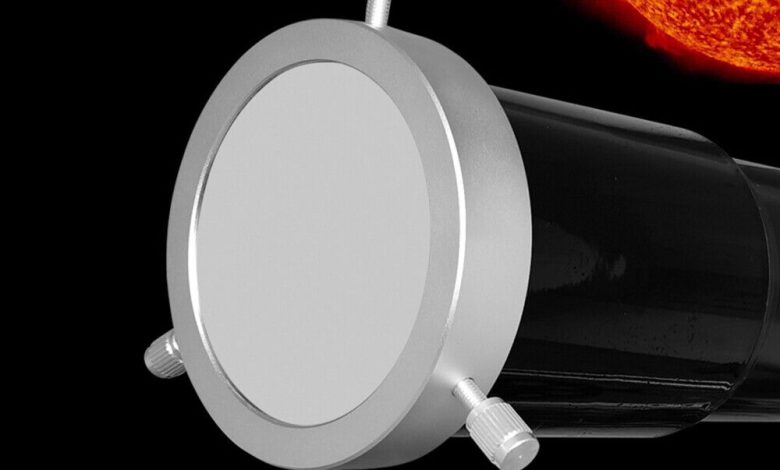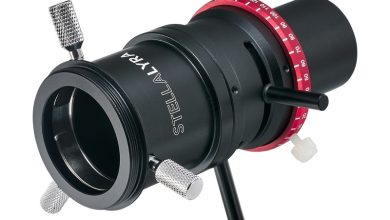
Observing the sun has never been more accessible or fascinating, thanks in large part to the advancements in solar filter technology. As the central star of our solar system, the sun offers a dynamic vista of solar phenomena—ranging from the mesmerizing dance of solar flares to the intricate patterns of sunspots. However, the intense brightness and potential harm posed by direct sunlight necessitate the use of specialized equipment. In this article, we’ll explore the world of solar filters for telescopes, a critical component for anyone eager to delve into solar observation.
Choosing the best solar filter for your telescope is pivotal not only for protecting your eyes but also for enhancing your viewing experience. Solar filters come in various types, each designed to fit different telescopes and viewing needs. Whether you’re a seasoned astronomer or a curious beginner, understanding the nuances of these filters is key to a safe and rewarding solar viewing experience.
Throughout this comprehensive guide, we will discuss the different types of solar filters available, focusing particularly on which ones are best suited for observing the sun through a telescope. We’ll explore everything from the basic solar film filters to the more advanced glass filters and delve into their specific uses, benefits, and limitations. Moreover, we’ll address common questions and provide insights into the optimal setups for various celestial events, including solar eclipses and planetary observations.
By the end of this exploration, you’ll be well-equipped with the knowledge to select the best solar filter for your telescope, ensuring that every solar observation is not only safe but spectacularly clear. Whether your interest lies in photographing solar eclipses or simply enjoying the daily wonders of the sun, the right solar filter will transform your astronomical experience. Let’s embark on this enlightening journey to unlock the secrets of the sun safely and effectively.
before Starting the article here is a great video about Best Filters for the ECLIPSE: Glass vs. Solar Film:
What is Best Solar Filter for Telescope
Solar filters are indispensable for safely observing the sun through a telescope. They not only protect your eyes from harmful solar radiation but also enhance the visual details of the sun’s surface by reducing its brightness. In this section, we’ll delve into the different types of solar filters, their safety standards, and guidance on choosing the right one for your telescope.
Types of Solar Filters
- Mylar Filters
Mylar filters are made from a polyester film coated with a thin layer of aluminum, which reflects solar radiation while allowing a small, safe amount of sunlight to pass through. These filters produce a blue-white image of the sun, which is clear enough to reveal large sunspots and solar eclipses. Mylar filters are lightweight, durable, and less expensive, making them a popular choice among amateur astronomers. They are best used for general solar viewing and photography, especially for those who are on a budget but still want to observe solar phenomena safely.
- Glass Filters
Glass solar filters offer superior optical quality compared to Mylar. These filters are made from optical-quality glass and coated with a metallic substance that blocks a significant amount of sunlight. The result is a sharper, more contrasted image of the sun, typically in an orange or yellow hue, which many users find more pleasing and easier to view. Glass filters are more durable and provide better clarity and detail, making them ideal for advanced solar observation and detailed astrophotography.

Safety Standards for Solar Filters
Safety is paramount when observing the sun, and using ISO-certified solar filters is crucial. ISO (International Organization for Standardization) provides a safety standard (ISO 12312-2) that solar filters must meet to be deemed safe for direct solar viewing. This certification ensures that the filter blocks enough solar radiation to protect your eyes effectively.
How to Check for Certification: When purchasing a solar filter, always check for the ISO 12312-2 certification mark on the product. This mark indicates that the filter has been tested and meets the stringent requirements for safety. Avoid using any solar filter that does not explicitly display this certification as using substandard filters can result in serious eye damage or blindness.
Choosing the Right Solar Filter
Selecting the right solar filter (Like other telescope accessories such as Atmospheric Dispenser Corrector) depends largely on the type of telescope you have and your observation goals. Here’s a quick guide:
- For Refractors and Reflectors: If you own a refractor or a reflector telescope, opt for a full-aperture solar filter that fits over the front end of the telescope. This setup ensures that no harmful solar rays enter the telescope at all.
- For Solar Photography: For those interested in solar photography, especially during events like solar eclipses, a high-quality glass filter will provide the best image clarity and detail.
- For Frequent Use: If you plan to observe the sun frequently, invest in a durable glass filter, as it will provide better performance and longevity compared to a Mylar filter.
- For Different Telescopes: Ensure that the filter fits snugly over your telescope’s aperture. Filters that are too large or too small can slip or allow unfiltered light to enter, compromising safety and observation quality.
By understanding these aspects of solar filters, you can make an informed decision that enhances your viewing experience while ensuring maximum safety. Whether you choose a Mylar or a glass filter, the key is to ensure it meets safety standards and matches your telescope type and observational needs.
Exploring Solar Telescopes
Solar telescopes are specifically designed for safe and effective observation of the sun. These instruments allow astronomers to observe solar phenomena such as sunspots, flares, and prominences in unprecedented detail. In this section, we will explore the different types of solar telescopes, their technological components, and provide recommendations tailored to various levels of astronomy enthusiasts.
Types of Solar Telescopes
- Dedicated Solar Telescopes
Dedicated solar telescopes are specifically built for solar observation. They typically incorporate built-in solar filters and specialized optical designs that enhance the visibility of solar features. These telescopes often utilize narrowband filters, such as H-alpha, to observe specific layers of the sun’s atmosphere, providing stunning views of solar activity.
- Regular Telescopes with Solar Filters
A more economical option for casual observers or those who already own a regular astronomical telescope is to use a solar filter. These filters can be attached to the front of any standard telescope, converting it into a device capable of safely viewing the sun. This setup is ideal for those who want a versatile telescope that can be used for both nighttime stargazing and daytime solar viewing.

Michael P. Caligiuri
Astronomy.com
FAQs about Best Solar Filter for Telescope
How Long Do Solar Filters Last? Do They Expire?
Solar filters do not have a definitive expiration date but can degrade over time depending on their material and how they are stored. Mylar filters, for example, can degrade quicker than glass filters. It is crucial to inspect your filter before each use and to store it properly when not in use. Keep the filter away from extreme temperatures and direct sunlight when stored, as these can cause the materials to degrade faster. Generally, if stored properly and undamaged, a good-quality solar filter can last several years. Always replace the filter if it shows any sign of wear or damage, regardless of its age.
Are There Different Types of Solar Filters for Different Types of Telescopes?
Yes, solar filters are specifically tailored for different types of telescopes. The primary categories are:
- Full-Aperture Solar Filters: These are the most common type of solar filter. They cover the entire aperture of the telescope and are used for both refractor and reflector telescopes. They offer excellent protection and clarity for observing the sun’s surface and are ideal for both visual observation and photography.
- Off-Axis Solar Filters: These filters cover only a part of the telescope’s aperture. They are generally used with larger telescopes to reduce the amount of heat entering the telescope, making them suitable for long-duration observations of the sun.
- Solar Filter Sheets: These are flexible sheets that you can cut to fit any telescope size. They are economical but require careful handling to avoid creating pinholes or tears.
Each type of filter has its specific application and suitability depending on the telescope's design and the observer's requirements. It’s essential to choose a filter that matches the aperture and focal length of your telescope to ensure safe and clear observations of the sun.
How Do I Test a Solar Filter's Effectiveness Before Using It?
To test the effectiveness of a solar filter, follow these steps:
- Visual Inspection: Before mounting the filter on your telescope, hold it up to a bright light source and examine it closely for any pinholes, scratches, or tears. Any damage could allow harmful sunlight to pass through.
- Sun Test: With the filter securely mounted on the end of your telescope, point the telescope at the sun and look through the eyepiece. You should see a uniformly dim, orange or white disk without any bright spots. If the sun appears too bright or if you see any light leaks around the edges of the filter, do not use the filter.
- Comfort Test: If viewing through the filter is comfortable for your eyes and the sun appears in a neutral color without any pain or discomfort, the filter is likely functioning correctly. Remember, direct solar observation should always be comfortable and not strain or hurt your eyes.
Technological Components
Understanding Etalons: Etalons are critical components in many high-end solar telescopes. An etalon is a type of filter that allows light of a specific wavelength to pass through while blocking others. This is particularly useful in solar observation to isolate the H-alpha light emitted by hydrogen in the sun’s atmosphere, which reveals details like solar flares and filaments.
Types of Solar Telescopes:
- H-alpha Telescopes: These telescopes are equipped with etalons that specifically target the H-alpha spectral line. They are excellent for viewing solar prominences, flares, and other surface activity.
- White-light Telescopes: These telescopes use filters that allow a broader range of wavelengths to pass through, providing a view of the sun’s photosphere. This is ideal for observing sunspots and granulation.
- Calcium-K Telescopes: These are specialized telescopes designed to observe the sun in the light of ionized calcium. These telescopes highlight the different layers of the sun’s atmosphere and are used to study more subtle solar activities.
Recommendations for Different User Levels
- For Beginners
Entry-level solar telescopes or regular telescopes with full-aperture solar filters are ideal for beginners. These setups are less expensive and provide a safe way to experience solar observation. Brands like Celestron and Meade offer telescopes and filters that are perfect for those new to the hobby.
- For Experienced Astronomers
For those who are more serious about solar astronomy, investing in a dedicated solar telescope equipped with an H-alpha or Calcium-K filter is advisable. High-end models from Lunt or Coronado provide superior optical quality and more detailed views of the sun’s dynamic activities.
- For Researchers and Advanced Enthusiasts
Advanced systems that include features like double-stacking etalons, which reduce the bandwidth further to enhance detail, or motorized tuning systems for adjusting the etalon on the fly, are best suited for researchers and those deeply involved in solar studies.
Choosing the right solar telescope involves considering your observational goals, budget, and the specific solar phenomena you are most interested in observing. By understanding the capabilities and limitations of each type of telescope and its components, you can make an informed decision that maximizes both your enjoyment and your educational experience in solar astronomy.

Thousand Oaks Optical
Astronomy.com
Observational Techniques for Solar Astronomy
Exploring the sun’s complex and dynamic surface requires not only the right equipment but also the mastery of specific observational techniques. In this section, we delve into direct and indirect methods of solar viewing and provide practical advice for those interested in photographing the sun.
Direct vs. Indirect Viewing
Benefits and Limitations of Each Method:
Direct Viewing: Direct viewing involves observing the sun directly through a telescope equipped with a solar filter. This method allows for real-time, detailed observation of solar phenomena such as sunspots, solar flares, and prominences.
- Benefits: Provides immediate and detailed views, which are essential for studying dynamic solar activities. It also allows for the use of various filters to observe different aspects of the sun.
- Limitations: Requires precise and high-quality solar filters to ensure eye safety. There is also a higher risk of accidental exposure if the equipment is not used correctly.
Indirect Viewing: Indirect viewing, or solar projection, involves projecting the image of the sun from a telescope onto a screen. This method is safer for group viewing and educational purposes.
- Benefits: Safely view the sun without looking directly through the telescope, making it ideal for public demonstrations and educational settings.
- Limitations: Generally offers less detail compared to direct viewing and can be affected by external light conditions. Not suitable for photographic documentation.
How to Set Up for Each Type of Viewing

Dylan O’Donnell
Astronomy.com
Direct Viewing Setup:
- Ensure your telescope is equipped with a certified solar filter securely attached to the front of the telescope.
- Align the telescope with the sun using the telescope’s finder scope, which should also be equipped with a solar filter.
- Adjust the focus until the sun’s image is sharp and clear.
- Regularly check the integrity of the solar filter throughout your observation session.
Indirect Viewing Setup:
- Mount your telescope and aim it toward the sun using a non-magnifying sighting device.
- Place a white screen a few feet from the eyepiece to capture the projected image of the sun.
- Adjust the telescope’s focus to sharpen the image on the screen.
- Ensure that no one attempts to look through the telescope during projection to avoid eye injury.
Photographing the Sun
Capturing the intricate details of the sun requires understanding the specific settings and equipment best suited for solar photography.
Tips for Using Solar Filters and Telescopes for Photography:
- Use a high-quality solar filter to ensure the safety of your eyes and camera.
- Employ a telescope with a tracking mount to keep the sun’s image stable during long exposures or time-lapses.
- Choose a camera capable of handling high-contrast environments, such as a DSLR or a dedicated astronomy camera.
Recommended Settings and Equipment:
- ISO: Keep the ISO setting low to minimize digital noise.
- Exposure: Use a fast shutter speed to capture clear images of fast-moving solar events.
- Aperture: Set a narrow aperture to increase the depth of field for sharper images.
- Additional Equipment: Consider using a Barlow lens to increase magnification, or a hydrogen-alpha filter to enhance the visibility of solar flares and prominences.
By mastering these observational techniques and understanding the optimal settings for solar photography, enthusiasts can safely explore and document the sun’s captivating features, turning fleeting moments of solar activity into lasting impressions of our closest star.

David Tyler
Astronomy.com
Practical Guide to Observing Solar Events
Preparing for a Solar Eclipse
- Specific Equipment Recommendations for Eclipse Viewing
For observing a solar eclipse, the best solar filter for a telescope is crucial. Opt for an ISO-certified Mylar or glass filter that fits snugly over your telescope’s aperture. Additional recommended equipment includes a sturdy tripod to stabilize your telescope and a remote shutter release for cameras to minimize shaking during photography.
- Timing and Planning for Optimal Observation
To maximize your eclipse viewing experience, plan to set up your observation station in a location predicted to fall within the path of totality or maximum coverage. Use astronomical software or mobile apps to track the timing of the eclipse phases precisely to ensure you don’t miss key moments like the first and last contact.
Regular Solar Observation
- Daily Sun Monitoring and What to Look For
Regular monitoring of the sun can reveal a wealth of dynamic activities. Key features to observe include sunspots, which vary in number and size with the solar cycle; solar flares, which appear as bright flashes; and solar prominences, which are large gaseous features that can be seen along the limb (edge) of the solar disc.
- Long-Term Projects and Research Opportunities
Engage in long-term projects such as tracking the solar cycle’s progression or contributing to databases that monitor solar activity. Many astronomy clubs and online communities offer collaborative projects, which can provide a structured way to contribute to scientific research and enhance your understanding of solar physics.
Safety First, Specially about Sun and Solar Filters
Detailed Safety Guidelines:
Proper Handling and Maintenance of Solar Viewing Equipment: Always inspect your solar filters for scratches, pinholes, or damage before and after observations. Even a small defect can let through harmful solar rays. Store your filters and telescopes in protective cases to avoid accidental damage.
Emergency Procedures for Accidental Direct Sun Exposure: In case of accidental exposure to unfiltered sunlight through a telescope, it is crucial to seek immediate ophthalmological advice. The intense solar rays can cause serious eye injuries, even from brief exposure.

Common Mistakes and Misconceptions in Using Solar Filters
- Addressing Myths About Solar Observation
A common myth is that sunglasses or smoked glass can safely filter sunlight for direct viewing, which is dangerously false. Only solar filters designed for the purpose should be used for looking at the sun.
- Correcting Improper Use of Equipment
Ensure that all solar filters are mounted securely on the telescope’s aperture end and not at the eyepiece as the concentrated solar rays can burn through or melt improper filters placed at the eyepiece.
Future Technologies and Developments
The field of solar astronomy is rapidly advancing with new technologies like solar radio interferometry and ultraviolet imaging. These technologies promise to reveal finer details of the sun’s atmosphere and magnetic fields. Future solar telescopes, such as the Daniel K. Inouye Solar Telescope (DKIST) in Hawaii, are set to provide unprecedented high-resolution images of the sun’s surface, allowing scientists to study solar phenomena in much greater detail than currently possible.
Last Words
As we continue to explore the myriad facets of our closest star, the importance of safe and informed solar observation cannot be overstated. By using the right equipment and techniques, adhering to safety guidelines, and engaging with the astronomy community, enthusiasts of all levels can enjoy the rich and rewarding pursuit of solar astronomy. Whether observing a rare solar eclipse or tracking the ever-changing sunspot patterns, each moment spent at the eyepiece deepens our connection to the cosmos and our understanding of the sun’s impact on our world.



